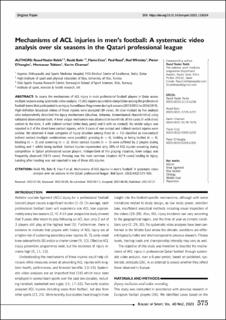| dc.contributor.author | Rekik, Raouf Nader | |
| dc.contributor.author | Bahr, Roald | |
| dc.contributor.author | Cruz, Flavio | |
| dc.contributor.author | Read, Paul | |
| dc.contributor.author | Whiteley, Rod | |
| dc.contributor.author | D'hooghe, Pieter | |
| dc.contributor.author | Tabben, Montassar | |
| dc.contributor.author | Chamari, Karim | |
| dc.date.accessioned | 2023-10-12T15:25:51Z | |
| dc.date.available | 2023-10-12T15:25:51Z | |
| dc.date.created | 2023-05-25T12:52:25Z | |
| dc.date.issued | 2023 | |
| dc.identifier.citation | Biology of Sport. 2023, 40(2), Side 575-586. | en_US |
| dc.identifier.issn | 0860-021X | |
| dc.identifier.uri | https://hdl.handle.net/11250/3096191 | |
| dc.description | This is an Open Access article distributed under the terms of Attribution-NonCommercial-NoDerivatives 4.0 International (CC BY-NC-ND 4.0) http://creativecommons.org/licenses/by-nc-nd/4.0), allowing third parties to copy and redistribute the material in any medium or format, provided that the article is properly cited, the use is non-commercial, and no modifications or adaptations are made. | en_US |
| dc.description.abstract | To assess the mechanisms of ACL injury in male professional football players in Qatar across multiple seasons using systematic video analysis. 15 ACL injuries occurred in competition among the professional football teams that participated in an injury Surveillance Programme during 6 seasons (2013/2014 to 2018/2019). High-definition broadcast videos of these injuries were analyzed (49 views; 34 slow motion) by five analysts who independently described the injury mechanisms (situation, behavior, biomechanical characteristics) using validated observational tools. A knee valgus mechanism was observed in two-thirds of the cases (1 with direct contact to the knee, 3 with indirect contact (other body parts) and 6 with no contact). No visible valgus was reported in 2 of the direct knee contact injuries, while 3 cases of non-contact and indirect contact injuries were unclear. We observed 4 main categories of injury situation among those (n = 12) classified as non-contact/indirect contact (multiple combinations were possible): pressing (n = 6), tackling or being tackled (n = 4), blocking (n = 3) and screening (n = 2). Direct contact injuries (n = 3) were suffered by 2 players during tackling and 1 whilst being tackled. Contact injuries represented only 20% of ACL injuries occurring during competition in Qatari professional soccer players. Independent of the playing situation, knee valgus was frequently observed (10/15 cases). Pressing was the most common situation (6/15 cases) leading to injury. Landing after heading was not reported in any of these ACL injuries. | en_US |
| dc.language.iso | eng | en_US |
| dc.subject | etiology | en_US |
| dc.subject | knee ligament | en_US |
| dc.subject | Middle East | en_US |
| dc.subject | prevention | en_US |
| dc.subject | risk factors | en_US |
| dc.subject | soccer | en_US |
| dc.title | Mechanisms of ACL injuries in men’s football: A systematic video analysis over six seasons in the Qatari professional league | en_US |
| dc.type | Peer reviewed | en_US |
| dc.type | Journal article | en_US |
| dc.description.version | publishedVersion | en_US |
| dc.rights.holder | © 2023 Institute of Sport – National Research Institute | en_US |
| dc.source.pagenumber | 575-586 | en_US |
| dc.source.volume | 40 | en_US |
| dc.source.journal | Biology of Sport | en_US |
| dc.source.issue | 2 | en_US |
| dc.identifier.doi | 10.5114/BIOLSPORT.2023.118024 | |
| dc.identifier.cristin | 2149238 | |
| dc.description.localcode | Institutt for idrettsmedisinske fag / Department of Sports Medicine | en_US |
| cristin.ispublished | true | |
| cristin.fulltext | original | |
| cristin.qualitycode | 1 | |
